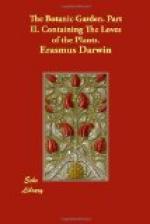O’er
her warm cheek the blush of beauty swims,
And
nerves Herculean bend her sinewy limbs;
With
frolic eye she views the affrighted throng,
190 And shakes the meadows, as she towers along,
With
playful violence displays her charms,
And
bears her trembling lovers in her arms.
So
fair THALESTRIS shook her plumy crest,
And
bound in rigid mail her jutting breast;
195 Poised her long lance amid the walks of war,
And
Beauty thunder’d from Bellona’s car;
Greece
arm’d in vain, her captive heroes wove
The
chains of conquest with the wreaths of love.
When
o’er the cultured lawns and dreary wastes
200 Retiring Autumn flings her howling blasts,
Bends
in tumultuous waves the struggling woods,
And
showers their leafy honours on the floods,
In
withering heaps collects the flowery spoil,
And
each chill insect sinks beneath the soil;
205 Quick flies fair TULIPA the loud alarms,
And
folds her infant closer in her arms;
In
some lone cave, secure pavilion, lies,
And
waits the courtship of serener skies.—
So,
six cold moons, the Dormouse charm’d to rest,
210 Indulgent Sleep! beneath thy eider breast,
In
fields of Fancy climbs the kernel’d groves,
Or
shares the golden harvest with his loves.—
[Tulipa. l. 205. Tulip. What is in common language called a bulbous root, is by Linneus termed the Hybernacle, or Winter-lodge of the young plant. As these bulbs in every respect resemble buds, except in their being produced under ground, and include the leaves and flower in miniature, which are to be expanded in the ensuing spring. By cautiously cutting in the early spring through the concentric coats of a tulip-root, longitudinally from the top to the base, and taking them off successively, the whole flower of the next summer’s tulip is beautifully seen by the naked eye, with its petals, pistil, and stamens; the flowers exist in other bulbs, in the same manner, as in Hyacinths, but the individual flowers of these being less, they are not so easily differed, or so conspicuous to the naked eye.
In the seeds of the Nymphaea Nelumbo, the leaves of the plant are seen so distinctly, that Mr. Ferber found out by them to what plant the seeds belonged. Amoen. Acad. V. vi. No. 120. He says that Mariotte first observed the future flower and foliage in the bulb of a Tulip; and adds, that it is pleasant to see in the buds of the Hepatica, and Pedicularia hirsuta, yet lying in the earth; and in the gems of Daphne Mezereon; and at the base of Osmunda Lunaria, a perfect plant of the future year compleat in all its parts. Ibid.]




